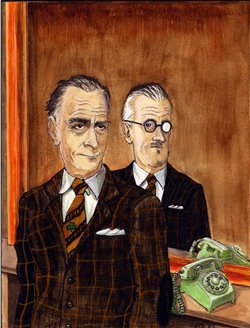After spending so much time studying and writing about John Bishop's Book of the Dark, a number of things have stuck with me. One of those is the word anastomosis.
Here's the definition from Wikipedia:
An anastomosis (plural anastomoses, from Greek ἀναστόμωσις, communicating opening) is the reconnection of two streams that previously branched out, such as blood vessels or leaf veins. The term is used in medicine, biology, mycology, geology, geography and architecture.and from Merriam-Webster:
the union of parts or branches (as of streams, blood vessels, or leaf veins) so as to intercommunicate or interconnect
This one word holds vital meaning for Bishop's thoroughly argued theory that all of the Wake takes place within the body of one man. The culmination of his theory and wonderful book holds that the sleeper regresses back to the womb state (which we all do when we sleep), when the connection of anastomosis made him one with the mother's body, which in Bishop's view is ALP.
We find HCE and ALP connected by anastomosis on page 585 of the Wake:
Humperfeldt and Anunska, wedded now evermore in annastomoses by a ground plan of the placehunter...In this case, "placehunter" is the placenta, giving strong credence to Bishop's interpretation.
But, as you can see from the definitions, this is a word that is used across many fields. The range of uses for the word implies a similarity between the nature of blood vessels, rivers, tree branches, rock veins, etc.
All of this also sounds like the nature of Finnegans Wake itself, a book which seems to feature biology, geology, neurology, history, geography, psychology, etc on just about every page, implying a similarity, a link, an anastomosis between all of these things.
The very way Joyce creates networks of meaning is a form of anastomosis. Words, motifs, themes, references branch out and connect with each other all over the book. The deeper you study it, the more you realize it's designed organically, the pages are a living fabric. The meanings grow and evolve each time you read it. That's why you'll always manage to find contemporary references in there (as in "Nike with your kickshoes on" pg 270 or pg 135: "handwriting on his facewall" which conjures Facebook).
As Dan Weiss wrote in his fantastic essay "Understanding the (Net) Wake":
As his daughter Lucia's schizophrenia worsened, Joyce alone had the ability to follow her giant-steps of thought that baffled others completely. His ability to traverse the flux of her wild metaphoric "correspondance"(452) is evident in his masterwork. If we imagine hero/male archetype/key nodal point H.C. Earwicker's "seven dams....and every dam had her seven crutches. And every crutch had its seven hues. And every hue had a differing cry"(215), we will have a good picture of the branching tree pathways that Joyce knew how to walk with Lucia. If we then imagine connecting every dam, crutch, hue and cry with every other dam, crutch, hue and cry, we will "translace"(233) that branching tree into the kind of network into which the reader of Finnegans Wake is dropped.Another appearance of "anastomosis" in Finnegans Wake comes in one of my favorite passages of the entire book, starting on page 614:
Our wholemole millwheeling vicociclometer, a tetradomational gazebocroticon ... autokinatonetically preprovided with a clappercoupling smeltingworks exprogressive process, (for the farmer, his son and their homely codes, known as eggburst, eggblend, eggburial and hatch-as-hatch can) receives through a portal vein the dialytically separated elements of precedent decomposition for the verypetpurpose of subsequent recombination so that the heroticisms, catastrophes and eccentricities transmitted by the ancient legacy of the past; type by tope, letter from litter, word at ward, with sendence of sundance... all, anastomosically assimilated and preteridentified paraidiotically, in fact, the sameold gamebold adomic structure of our Finnius the old One, as highly charged with electrons as hophaz- ards can effective it, may be there for you, Cockalooralooraloomenos, when cup, platter and pot come piping hot, as sure as herself pits hen to paper and there's scribings scrawled on eggs.One of the reasons I've always loved this passage is because it feels like a breakdown or explanation of the living machine Joyce sought to engineer with Finnegans Wake (he called himself "the greatest engineer who ever lived" after all). In the hopes of keeping this post short, I won't go deep into the passage but I just want to point out the use of "anastomosically" here. What this passage seems to be saying is that the Wake takes all of the elements of history, breaks them down to their "dialytically separated elements" and reconnects them via branches.
Or something like that.




